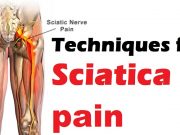After nights spent sleeping on her side, Gigi Howard, a former public relations executive, would wake up with lines etched into her décolletage. By day she wore scarves to hide the wrinkles. At night, she searched for a solution.
“I’d sleep with stuffed animals between my breasts,” Ms. Howard said. “I tried masking tape, but it wouldn’t stay on. I needed an adhesive that would fold with the skin to prevent the creasing. I was thinking duct tape.”
One day in a doctor’s office, she discovered a piece of medical-grade silicone — and had a light-bulb moment. After spending three and a half years testing, and creating more than 100 prototypes (her toddler son, Southworth, took to wearing the rejected pads all over his tummy), she arrived at the SiO SkinPad, an hourglass-shape, medical-grade silicone pad that is worn overnight to keep skin from crinkling.
Dr. Dendy Engelman, a dermatologist in New York and a medical adviser for SiO, explained that the pad works by preventing creasing and creating a wrinkle-fighting environment under the silicone. “We know medical-grade silicone has healing properties,” Dr. Engelman said. “Doctors use it all the time for scarring. The mechanism is not 100 percent elucidated, but the theory is that it increases growth factors to help wound healing and decreases the mediators that cause excess scarring.”
Ms. Howard’s product arrives at a time when doctors are turning their attention to the often-neglected area. “People have been taking better care of their facial skin in recent years, but a face that looks youthful paired with a neck and chest that show the signs of sun damage and photo-aging can make people look unnatural and ‘done,’” said Dr. Dara Liotta, a plastic surgeon in New York. “It’s important to focus some energy on the neck and chest so you match.”
Fade the Dark Spots
After years of sun exposure, dark spots and broken capillaries can populate the chest. An intense pulsed light (also called broadband light), applied in a doctor’s office, can correct both. The light targets unwanted pigment, breaking it up so it can be absorbed by the body. “It’s superficial, requires little downtime and has a light collagen-building effect,” Dr. Engelman said of the treatment. It is also less expensive (around $600) than the popular Fraxel lasers, which trigger the skin’s wound-healing response to stimulate collagen growth.
Smooth the Crinkles
Crinkly skin below the chin is caused primarily by sun damage leading to collagen loss. “The sun hits directly on the chest and has a skin-thinning effect,” said Dr. Jeannette Graf, a dermatologist in New York. Fortunately, this inevitable damage is treatable in a number of noninvasive ways. Lasers such as the Fraxel can be used safely on the neck and décolletage.
Dr. Anne Chapas, a dermatologist in Manhattan, recently studied the effect of photodynamic therapy, a light treatment traditionally used for skin cancers, as a cosmetic option for the chest. “It’s a new take on a technology that’s been used in the medical realm for a while,” Dr. Chapas said. “There’s improvement of the chest — wrinkles, brown discolorations — after three sessions.”
During the procedure, a photosensitive lotion containing aminolevulinic acid is applied to the skin and absorbed by only damaged cells. An intense pulsed light laser then activates the lotion. At around $600 a session, it, too, costs less than many laser treatments, which can be twice as much.
Also, injectable dermal fillers, like Belotero, can plump the skin up from within. “It works superficially so you can correct those fine etch-a-sketch lines,” Dr. Graf said.
Tighten the Turkey Neck
Loose skin and thick banding of the platysma muscle (which runs from chin to clavicle) create the look we call “turkey neck.” Treatment options depend on the severity of the sagging. “Ultherapy” is a noninvasive ultrasound therapy that injures the tissue surrounding the muscles, setting off a healing response that creates more collagen, which in turn tightens and lifts skin gradually. The procedure works for those with mild sagging; very loose skin is best corrected by surgery.
“Some people lose skin elasticity faster than others for genetic reasons,” said Dr. Patrick K. Sullivan, a plastic surgeon and associate professor at Brown. Skin removal is required, Dr. Sullivan said, because there are no great noninvasive treatments “that will have you looking like you’re 20 years old again.”
Thickening and protrusion of the platysma muscle is also common. “If the person has really good skin, and the problem is just these muscle bands, we can use Botox from top to bottom to relax them,” he said.
Shrink the Double Chin
While most neck and chest problems begin to plague us as we reach middle age, a double chin lacks that partiality. Anyone can have one, and Kybella, an injectable acid, can treat the condition. The acid dissolves superficial chin fat (meaning that fat between skin and muscle). Patients may need multiple treatments, which are spaced a month apart. The cost of a first treatment is around $1,200.
Dr. Sullivan explained that some people have fat underneath the muscle, which is usually a hereditary condition. Kybella and other less invasive options can’t get to that deep fat, so surgery is best. “We make an incision at the chin region, lift up the platysma muscle, then contour down the fat,” he said. You don’t want to take away all of the fat, but just enough to give a natural shape.”
To figure out your double-chin type, pinch the area, then swallow. “If the fat just stays there between your fingers, there’s a much better chance the fat is beneath the skin and you can be treated with Kybella,” Dr. Sullivan said.
How to Maintain Progress at Home
Daily sunscreen is a must for prevention. For damage that’s already done, try these at-home products. They were cited by a number of doctors for being effective in treating mild signs of aging — and as good maintenance after in-office procedures.







































